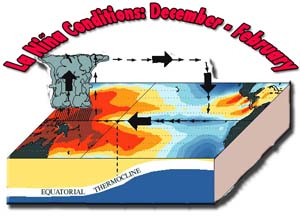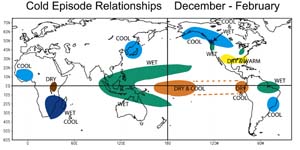| NOAA Magazine || NOAA Home Page |
NOAA PREDICTS WEAK LA NIÑA
 Jan.
12, 2006 � Weak La
Niña conditions are predicted in the tropical Pacific just
in time for spring, but NOAA scientists
stress it is too early to know how this could affect springtime and
summertime weather patterns in the United States. La Niña is
the periodic cooling of ocean waters in the east-central equatorial
Pacific, which impacts the typical alignment of weather patterns. (Click
NOAA image for larger view of La Niña conditions during December
through February. Please credit “NOAA.”)
Jan.
12, 2006 � Weak La
Niña conditions are predicted in the tropical Pacific just
in time for spring, but NOAA scientists
stress it is too early to know how this could affect springtime and
summertime weather patterns in the United States. La Niña is
the periodic cooling of ocean waters in the east-central equatorial
Pacific, which impacts the typical alignment of weather patterns. (Click
NOAA image for larger view of La Niña conditions during December
through February. Please credit “NOAA.”)
Today, scientists at the NOAA Climate Prediction Center released the latest El Niño Southern Oscillation Diagnostic Discussion, which highlights the early stages of a weak La Niña episode developing in the tropical Pacific and, for now, are expected to remain in place for three to six months. Yet the full impact of this weak event is yet unknown. Jim Laver, director of the NOAA Climate Prediction Center, the lead government agency on El Niño/La Niña monitoring and forecasting, said "The strength of La Niña's impacts depends on the strength of the La Niña's event."
Wayne Higgins, NOAA's principal climate specialist at the NOAA Climate Prediction Center said, "One thing, however, is for certain. La Nina was not the cause of the early January rains in the West and wildfires in the South." He added, "While La Niña can produce similar patterns, there is no indication that these jet stream winds are related to the developing weak La Niña."
 La
Niña events recur approximately every three to five years. The
last La Niña occurred in 2000-2001 and was a weak event.
La
Niña events recur approximately every three to five years. The
last La Niña occurred in 2000-2001 and was a weak event.
NOAA will continue monitoring this event and report on any potential impacts as the event progresses. The next ENSO Diagnostic Discussion will be posted on the NOAA Climate Prediction Center Web site on February 9. (Click NOAA image for larger view of La Niña global impacts during December through February. NOAA scientists stress it is too early to know how this could affect springtime and summertime weather patterns in the United States. Click here for high resolution version. Please credit “NOAA.”)
The El Niño/Southern Oscillation Diagnostic Discussion is a team effort consisting of NOAA’s Climate Prediction Center, Climate Diagnostics Center, National Climatic Data Center, Geophysical Fluid Dynamics Laboratory, Atlantic Oceanographic and Meteorological Laboratory, and the International Research Institute for Climate Prediction.
NOAA, an
agency of the U.S. Department of
Commerce, is dedicated to enhancing economic security and national
safety through the prediction and research of weather and climate-related
events and providing environmental stewardship of the nation's coastal
and marine resources.
Through the emerging Global Earth Observation System of Systems (GEOSS),
NOAA is working with its federal partners and nearly 60 countries to
develop a global monitoring network that is as integrated as the planet
it observes.
Relevant Web Sites
NOAA
La Niña Episodes in the Tropical Pacific
NOAA Climate Prediction Center La Niña/El Niño
NOAA El Niño Southern Oscillation Discussion
NOAA Latest Weekly ENSO Forecast Update (PDF)
Media
Contact:
Carmeyia Gillis, NOAA
Climate Prediction Center, (301) 763-8000 ext. 7163